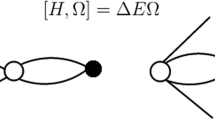Abstract
The relaxation of diatomic molecules (harmonic oscillators) in a relatively light inert gas, which plays the part of a thermostat, is considered within the framework of classical mechanics. The gas-kinetic equation for the distribution function of diatomic molecules is approximated by the Fokker-Planck equation in the space of the energies of translational, rotational and vibrational motions on the assumption of strong nonadiabaticity of the collisions. In the approximation discussed, relaxation processes with different degrees of freedom develop independently, although the characteristic times of these processes are quantities of the same order. The vibrational relaxation time, expressed in terms of the gas-kinetic integral Ω*(1,1) (T*), is obtained.
Similar content being viewed by others
References
M. N. Safaryan and E. V. Stupochenko, “Rotational relaxation of diatomic molecules in a light inert gas, PMTF, no. 4, 1964.
J. Hirschfelder, C. Curtiss, and P. Bird, Molecular Theory of Gases and Liquids [Russian translation], IL, Moscow, 1961.
A. I. Osipov, “Vibrational relaxation of diatomic molecules in nonadiabatic collisions,” Zh. fiz. khimii, vol. 37, no. 12, 1963.
G. K. Tvanov and Yu. S. Sayasov, “The theory of vibrational excitation of molecules in the momentum approximation,” DAN SSSR, vol. 154, no. 6, 1964.
Author information
Authors and Affiliations
Rights and permissions
About this article
Cite this article
Safaryan, M.N., Stupochenko, E.V. On the theory of vibrational relaxation of diatomic molecules. J Appl Mech Tech Phys 6, 83–85 (1965). https://doi.org/10.1007/BF00914374
Issue Date:
DOI: https://doi.org/10.1007/BF00914374




